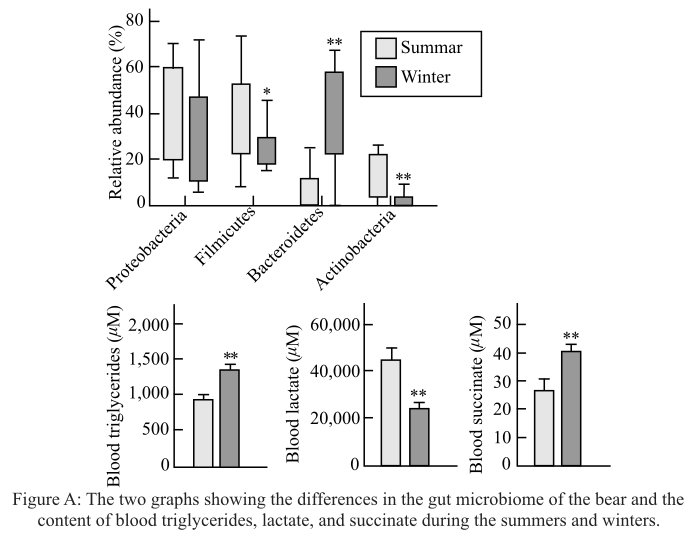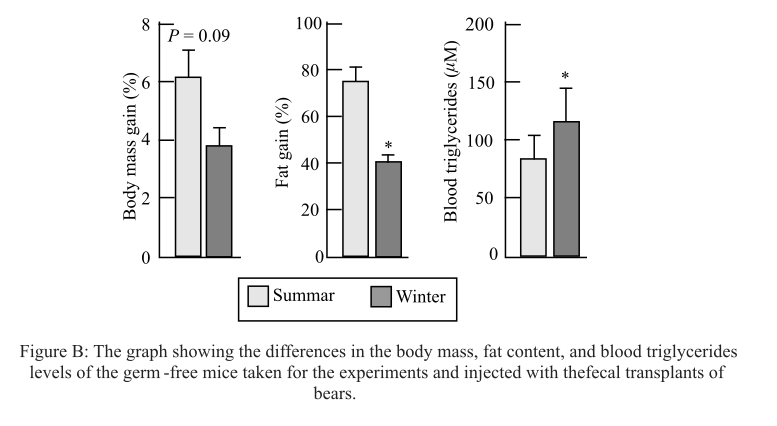
Concept explainers
To review:
The digestive adaptations of brown bears that help them in surviving in their native habitat.
Given:
The brown bears (Ursus arctos) were taken by the researchers for studying the role of gut microbiota in the digestion of food and in many other aspects of nutrition. Brown bears undergo hibernation when the environment is extreme cold. They analyzed whether microbiome of the bear’s gut was different before and after fasting. They studied the blood and the fecal samples from 16 free-ranging brown bears during hibernation (February or March) and following hibernation (June). There was presence of the different microbe communities in different amounts during different seasons and same was with the triglycerides and other nutrients.
The following graphs were plotted after observing the conditions in winters and summers. Graph 1 shows the presence of different composition of the microbiome during different seasons. Also, the differences in the blood levels of triglycerides, lactate, and succinate are depicted.
The effects of the microbiota were also examined after introducing them into germ-free mice. Germ-free mice, unlike normal mice are devoid of gut microbiota and are unable to gain mass when they are kept on a high-fat diet. Fecal transplants from summer and the winter bears were given to the germ-free mice. Graph 2 shows the changes in body mass, fat content, and blood triglyceride levels of the mice after two weeks.

Graph 1: The two graphs showing the differences in the gut microbiome of the bear and the content of blood triglycerides, lactate, and succinate during the summers and winters.

Graph 2: The graph showing the differences in the body mass, fat content, and blood triglycerides level of the germ-free mice taken for the experiments and injected with the fecal transplants of bears.
Introduction:
Germ-free mice are those mice that do not have any microbes in their gut. These mice are different from the normal mice as they are unable to gain weight, when kept on high fat diet. These mice are used for experiment and introduced with the microbiota of summer bears and winter bears. The difference in the microbiota lead to the difference in body mass of the mice.
Want to see the full answer?
Check out a sample textbook solution
Chapter 50 Solutions
Life: The Science of Biology
- How might natural selection favor a carnivore that spends more time and energy capturing large prey than small prey?arrow_forwardWhat are the key evolutionary adaptations that diving mammals use to survive at significant ocean depths?arrow_forwardName three “unique” characteristics observed in the dogfish shark and explain how these features make the shark better suited to succeed in its environment or as a predator.arrow_forward
- Two principal groups of fishes, with respect to feeding behavior, are carnivores and suspension feeders. How are these two groups adapted for their feeding behavior?arrow_forwardDescribe the different variations in mammalian digestive systems.arrow_forwardP. boisei and H. habilis lived alongside one another in East Africa. What are their inferred foods? Ho do we know this? (what are their teeth and skull characteristics)?arrow_forward
- Which primates have the most anatomical and physiological digestive specializations? a. Lemurs b. Gibbons c. Gorillas d. Tarsiers e. Colobine monkeysarrow_forwardDiscuss the adaptations of lower chordate to survival in terms of feedingarrow_forwardHow has the digestive system evolved when comparing the pig to the lamprey and the shark?arrow_forward
- How Do Energy Budgets Differ for Three TerrestrialVertebrates?arrow_forwardDiscuss the adaptations of lower chordates to survival in terms of Nutritionarrow_forwardDescribe the behavioural and physiological adaptations that enable many rodents to thrive in arid environments (long answer)arrow_forward
 Biology: The Dynamic Science (MindTap Course List)BiologyISBN:9781305389892Author:Peter J. Russell, Paul E. Hertz, Beverly McMillanPublisher:Cengage Learning
Biology: The Dynamic Science (MindTap Course List)BiologyISBN:9781305389892Author:Peter J. Russell, Paul E. Hertz, Beverly McMillanPublisher:Cengage Learning
